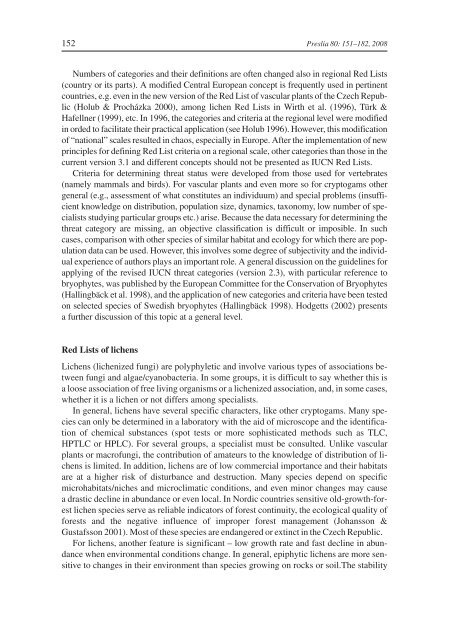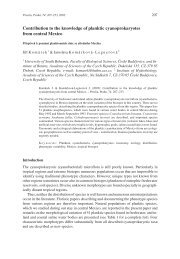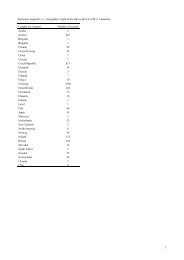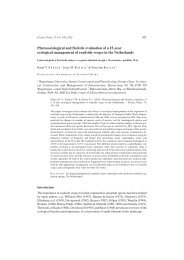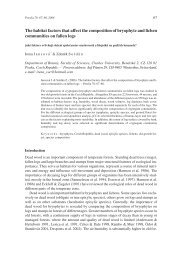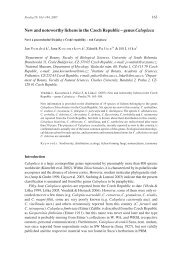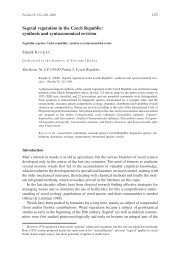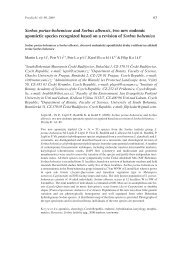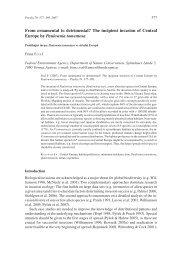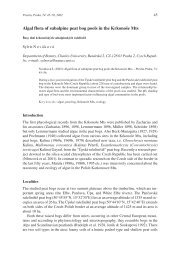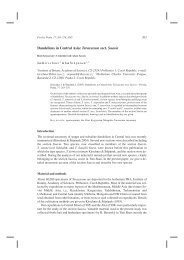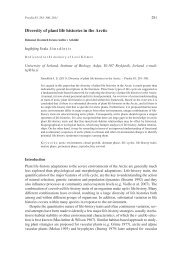Checklist and Red List of lichens of the Czech Republic
Checklist and Red List of lichens of the Czech Republic
Checklist and Red List of lichens of the Czech Republic
Create successful ePaper yourself
Turn your PDF publications into a flip-book with our unique Google optimized e-Paper software.
152 Preslia 80: 151–182, 2008<br />
Numbers <strong>of</strong> categories <strong>and</strong> <strong>the</strong>ir definitions are <strong>of</strong>ten changed also in regional <strong>Red</strong> <strong>List</strong>s<br />
(country or its parts). A modified Central European concept is frequently used in pertinent<br />
countries, e.g. even in <strong>the</strong> new version <strong>of</strong> <strong>the</strong> <strong>Red</strong> <strong>List</strong> <strong>of</strong> vascular plants <strong>of</strong> <strong>the</strong> <strong>Czech</strong> <strong>Republic</strong><br />
(Holub & Procházka 2000), among lichen <strong>Red</strong> <strong>List</strong>s in Wirth et al. (1996), Türk &<br />
Hafellner (1999), etc. In 1996, <strong>the</strong> categories <strong>and</strong> criteria at <strong>the</strong> regional level were modified<br />
in orded to facilitate <strong>the</strong>ir practical application (see Holub 1996). However, this modification<br />
<strong>of</strong> “national” scales resulted in chaos, especially in Europe. After <strong>the</strong> implementation <strong>of</strong> new<br />
principles for defining <strong>Red</strong> <strong>List</strong> criteria on a regional scale, o<strong>the</strong>r categories than those in <strong>the</strong><br />
current version 3.1 <strong>and</strong> different concepts should not be presented as IUCN <strong>Red</strong> <strong>List</strong>s.<br />
Criteria for determining threat status were developed from those used for vertebrates<br />
(namely mammals <strong>and</strong> birds). For vascular plants <strong>and</strong> even more so for cryptogams o<strong>the</strong>r<br />
general (e.g., assessment <strong>of</strong> what constitutes an individuum) <strong>and</strong> special problems (insufficient<br />
knowledge on distribution, population size, dynamics, taxonomy, low number <strong>of</strong> specialists<br />
studying particular groups etc.) arise. Because <strong>the</strong> data necessary for determining <strong>the</strong><br />
threat category are missing, an objective classification is difficult or imposible. In such<br />
cases, comparison with o<strong>the</strong>r species <strong>of</strong> similar habitat <strong>and</strong> ecology for which <strong>the</strong>re are population<br />
data can be used. However, this involves some degree <strong>of</strong> subjectivity <strong>and</strong> <strong>the</strong> individual<br />
experience <strong>of</strong> authors plays an important role. A general discussion on <strong>the</strong> guidelines for<br />
applying <strong>of</strong> <strong>the</strong> revised IUCN threat categories (version 2.3), with particular reference to<br />
bryophytes, was published by <strong>the</strong> European Committee for <strong>the</strong> Conservation <strong>of</strong> Bryophytes<br />
(Hallingbäck et al. 1998), <strong>and</strong> <strong>the</strong> application <strong>of</strong> new categories <strong>and</strong> criteria have been tested<br />
on selected species <strong>of</strong> Swedish bryophytes (Hallingbäck 1998). Hodgetts (2002) presents<br />
a fur<strong>the</strong>r discussion <strong>of</strong> this topic at a general level.<br />
<strong>Red</strong> <strong>List</strong>s <strong>of</strong> <strong>lichens</strong><br />
Lichens (lichenized fungi) are polyphyletic <strong>and</strong> involve various types <strong>of</strong> associations between<br />
fungi <strong>and</strong> algae/cyanobacteria. In some groups, it is difficult to say whe<strong>the</strong>r this is<br />
a loose association <strong>of</strong> free living organisms or a lichenized association, <strong>and</strong>, in some cases,<br />
whe<strong>the</strong>r it is a lichen or not differs among specialists.<br />
In general, <strong>lichens</strong> have several specific characters, like o<strong>the</strong>r cryptogams. Many species<br />
can only be determined in a laboratory with <strong>the</strong> aid <strong>of</strong> microscope <strong>and</strong> <strong>the</strong> identification<br />
<strong>of</strong> chemical substances (spot tests or more sophisticated methods such as TLC,<br />
HPTLC or HPLC). For several groups, a specialist must be consulted. Unlike vascular<br />
plants or macr<strong>of</strong>ungi, <strong>the</strong> contribution <strong>of</strong> amateurs to <strong>the</strong> knowledge <strong>of</strong> distribution <strong>of</strong> <strong>lichens</strong><br />
is limited. In addition, <strong>lichens</strong> are <strong>of</strong> low commercial importance <strong>and</strong> <strong>the</strong>ir habitats<br />
are at a higher risk <strong>of</strong> disturbance <strong>and</strong> destruction. Many species depend on specific<br />
microhabitats/niches <strong>and</strong> microclimatic conditions, <strong>and</strong> even minor changes may cause<br />
a drastic decline in abundance or even local. In Nordic countries sensitive old-growth-forest<br />
lichen species serve as reliable indicators <strong>of</strong> forest continuity, <strong>the</strong> ecological quality <strong>of</strong><br />
forests <strong>and</strong> <strong>the</strong> negative influence <strong>of</strong> improper forest management (Johansson &<br />
Gustafsson 2001). Most <strong>of</strong> <strong>the</strong>se species are endangered or extinct in <strong>the</strong> <strong>Czech</strong> <strong>Republic</strong>.<br />
For <strong>lichens</strong>, ano<strong>the</strong>r feature is significant – low growth rate <strong>and</strong> fast decline in abundance<br />
when environmental conditions change. In general, epiphytic <strong>lichens</strong> are more sensitive<br />
to changes in <strong>the</strong>ir environment than species growing on rocks or soil.The stability


